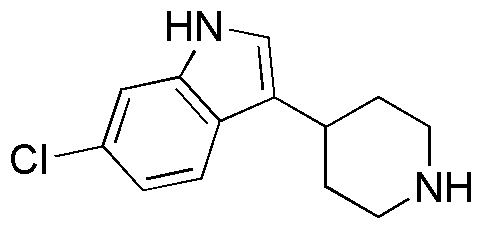6-Chloro-3-piperidin-4-yl-1H-indole is widely utilized in research focused on:
- Pharmaceutical Development: This compound serves as a key intermediate in the synthesis of various pharmaceuticals, particularly in the development of drugs targeting neurological disorders.
- Biological Research: It is employed in studies investigating receptor interactions, helping researchers understand mechanisms of action for potential therapeutic agents.
- Medicinal Chemistry: The compound is used to design and optimize new drug candidates, enhancing efficacy and reducing side effects in treatments.
- Chemical Biology: It plays a role in probing biological pathways, allowing scientists to explore cellular processes and disease mechanisms.
- Material Science: The compound can be incorporated into polymers or coatings, providing unique properties for advanced materials in various applications.
General Information
Properties
Safety and Regulations
Applications
6-Chloro-3-piperidin-4-yl-1H-indole is widely utilized in research focused on:
- Pharmaceutical Development: This compound serves as a key intermediate in the synthesis of various pharmaceuticals, particularly in the development of drugs targeting neurological disorders.
- Biological Research: It is employed in studies investigating receptor interactions, helping researchers understand mechanisms of action for potential therapeutic agents.
- Medicinal Chemistry: The compound is used to design and optimize new drug candidates, enhancing efficacy and reducing side effects in treatments.
- Chemical Biology: It plays a role in probing biological pathways, allowing scientists to explore cellular processes and disease mechanisms.
- Material Science: The compound can be incorporated into polymers or coatings, providing unique properties for advanced materials in various applications.
Documents
Safety Data Sheets (SDS)
The SDS provides comprehensive safety information on handling, storage, and disposal of the product.
Product Specification (PS)
The PS provides a comprehensive breakdown of the product’s properties, including chemical composition, physical state, purity, and storage requirements. It also details acceptable quality ranges and the product's intended applications.
Certificates of Analysis (COA)
Search for Certificates of Analysis (COA) by entering the products Lot Number. Lot and Batch Numbers can be found on a product’s label following the words ‘Lot’ or ‘Batch’.
*Catalog Number
*Lot Number
Certificates Of Origin (COO)
This COO confirms the country where the product was manufactured, and also details the materials and components used in it and whether it is derived from natural, synthetic, or other specific sources. This certificate may be required for customs, trade, and regulatory compliance.
*Catalog Number
*Lot Number
Safety Data Sheets (SDS)
The SDS provides comprehensive safety information on handling, storage, and disposal of the product.
DownloadProduct Specification (PS)
The PS provides a comprehensive breakdown of the product’s properties, including chemical composition, physical state, purity, and storage requirements. It also details acceptable quality ranges and the product's intended applications.
DownloadCertificates of Analysis (COA)
Search for Certificates of Analysis (COA) by entering the products Lot Number. Lot and Batch Numbers can be found on a product’s label following the words ‘Lot’ or ‘Batch’.
*Catalog Number
*Lot Number
Certificates Of Origin (COO)
This COO confirms the country where the product was manufactured, and also details the materials and components used in it and whether it is derived from natural, synthetic, or other specific sources. This certificate may be required for customs, trade, and regulatory compliance.


